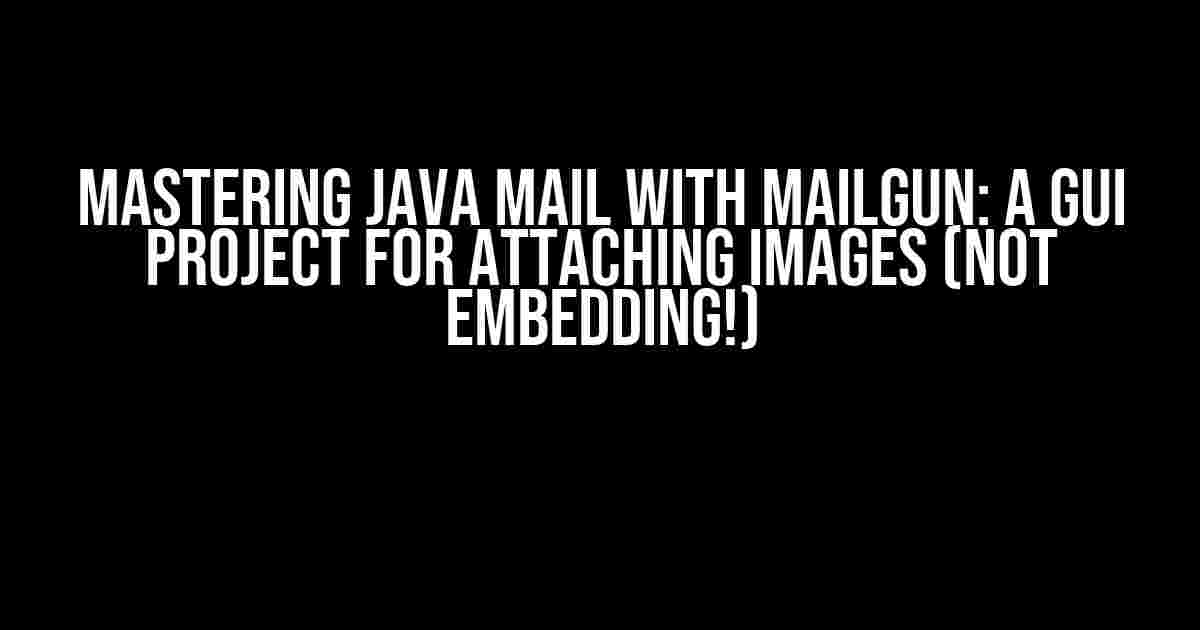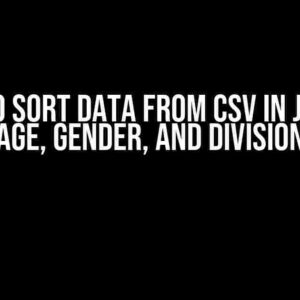Are you tired of struggling with sending emails with attachments using Java Mail? Do you want to learn how to create a GUI project that attaches images without embedding them? Look no further! In this article, we’ll take you on a step-by-step journey to create a Java Mail project that integrates with Mailgun, allowing you to send emails with attached images.
What You’ll Need
- Java Development Kit (JDK) 8 or later
- Apache NetBeans IDE or your preferred IDE
- Mailgun account (sign up for a free account if you don’t have one)
- Java Mail API (download the latest version)
- A GUI builder tool (we’ll use NetBeans’ built-in GUI builder)
Setting Up the Project
Create a new Java project in NetBeans and add the Java Mail API to your project’s library. You can do this by right-clicking on your project > Properties > Libraries > Add Library > Java Mail API.
Next, create a new GUI form by going to File > New File > GUI Forms > JFrame Form. Name your form “MailClientGUI” and set its size to 600×400 pixels.
Designing the GUI
Drag and drop the following components onto your form:
- Text field (for the recipient’s email address)
- Text field (for the email subject)
- Text area (for the email body)
- Button (for attaching images)
- Button (for sending the email)
- Label (for displaying the attached image)
Arrange the components as follows:
| Recipient’s Email: | |
| Email Subject: | |
| Email Body: | |
| Attach Image: | |
| Attached Image: | |
Writing the Java Code
Create a new Java class called “MailClient” and add the following code:
import java.awt.*;
import java.awt.event.*;
import java.io.*;
import java.util.*;
import javax.mail.*;
import javax.mail.internet.*;
public class MailClient {
private JTextField recipientEmailField;
private JTextField emailSubjectField;
private JTextArea emailBodyArea;
private JButton attachImageBtn;
private JLabel attachedImageLabel;
private JButton sendEmailBtn;
private String attachedImageFilePath;
public MailClient() {
// Initialize GUI components
recipientEmailField = new JTextField();
emailSubjectField = new JTextField();
emailBodyArea = new JTextArea();
attachImageBtn = new JButton("Browse...");
attachedImageLabel = new JLabel();
sendEmailBtn = new JButton("Send Email");
// Add event listeners
attachImageBtn.addActionListener(new AttachImageListener());
sendEmailBtn.addActionListener(new SendEmailListener());
}
private class AttachImageListener implements ActionListener {
public void actionPerformed(ActionEvent e) {
JFileChooser fileChooser = new JFileChooser();
fileChooser.setFileSelectionMode(JFileChooser.FILES_ONLY);
int result = fileChooser.showOpenDialog(null);
if (result == JFileChooser.APPROVE_OPTION) {
File selectedFile = fileChooser.getSelectedFile();
attachedImageFilePath = selectedFile.getAbsolutePath();
attachedImageLabel.setText(selectedFile.getName());
}
}
}
private class SendEmailListener implements ActionListener {
public void actionPerformed(ActionEvent e) {
try {
// Create a Mailgun API instance
MailgunApi api = new MailgunApi("your.mailgun.domain", "your.mailgun.api.key");
// Create a new email message
MimeMessage message = new MimeMessage(Session.getInstance(new Properties()));
message.setFrom(new InternetAddress("your.email.address", "Your Name"));
message.addRecipient(Message.RecipientType.TO, new InternetAddress(recipientEmailField.getText()));
message.setSubject(emailSubjectField.getText());
message.setText(emailBodyArea.getText());
// Attach the selected image
if (attachedImageFilePath != null) {
MimeBodyPart imageBodyPart = new MimeBodyPart();
imageBodyPart.attachFile(attachedImageFilePath);
imageBodyPart.setDisposition(BodyPart.ATTACHMENT);
imageBodyPart.setFileName(attachedImageLabel.getText());
Multipart multipart = new MimeMultipart();
multipart.addBodyPart(imageBodyPart);
message.setContent(multipart);
}
// Send the email using Mailgun
api.sendMessage("your.mailgun.domain", message);
JOptionPane.showMessageDialog(null, "Email sent successfully!");
} catch (Exception ex) {
JOptionPane.showMessageDialog(null, "Error sending email: " + ex.getMessage());
}
}
}
}
Mailgun API Integration
Create a new class called “MailgunApi” and add the following code:
import java.util.*;
import org.apache.http.*;
import org.apache.http.client.methods.*;
import org.apache.http.entity.mime.*;
public class MailgunApi {
private String domain;
private String apiKey;
public MailgunApi(String domain, String apiKey) {
this.domain = domain;
this.apiKey = apiKey;
}
public void sendMessage(String domain, MimeMessage message) throws Exception {
HttpPost post = new HttpPost("https://" + domain + "/messages");
post.setHeader("Authorization", "Basic " + Base64.getEncoder().encodeToString(("api:" + apiKey).getBytes()));
MultipartEntity entity = new MultipartEntity();
entity.addPart("from", new StringBody(message.getFrom()[0].toString()));
entity.addPart("to", new StringBody(message.getRecipients(Message.RecipientType.TO)[0].toString()));
entity.addPart("subject", new StringBody(message.getSubject()));
entity.addPart("text", new StringBody(message.getContent().toString()));
if (message.getContent() instanceof Multipart) {
Multipart multipart = (Multipart) message.getContent();
for (int i = 0; i < multipart.getCount(); i++) {
BodyPart bodyPart = multipart.getBodyPart(i);
if (bodyPart.getFileName() != null) {
entity.addPart("attachment", new FileBody(new File(bodyPart.getFileName())));
}
}
}
post.setEntity(entity);
CloseableHttpResponse response = HttpClientBuilder.create().build().execute(post);
response.close();
}
}
Conclusion
That's it! You now have a fully functional Java Mail project that integrates with Mailgun, allowing you to send emails with attached images. Simply run your project, fill in the GUI fields, attach an image, and click the "Send Email" button.
Remember to replace the placeholders "your.mailgun.domain", "your.mailgun.api.key", and "your.email.address" with your actual Mailgun domain, API key, and email address.
This project demonstrates the power of Java Mail and Mailgun, making it easy to create robust email clients with advanced features like image attachments. With this knowledge, you can create more complex email clients that cater to your specific needs.
Troubleshooting
If you encounter any issues with your project, make sure to check the following:
- Verify that you've replaced the placeholders with your actual Mailgun credentials and email address.
- Check that you've added the Java Mail API to your project's library.
- Ensure that you've set the correct file path for the attached image.
- Test your Mailgun API credentials by sending a test email using the Mailgun API documentation.
By following this tutorial, you should now have a solid understanding of how to create a Java Mail project with Mailgun integration, enabling you to send emails with attached images. Happy coding!
Frequently Asked Questions
Get answers to your burning questions about Java Mail Mailgun GUI project and attaching images without embedding them!
Why do I need to attach images instead of embedding them in my Java Mail Mailgun GUI project?
Attaching images instead of embedding them allows the recipient's email client to handle the image display, which can improve deliverability and reduce the risk of images being flagged as spam. Plus, it gives the recipient more control over how they want to view the image!
How do I attach an image to an email in my Java Mail Mailgun GUI project?
You can attach an image to an email in your Java Mail Mailgun GUI project by using the `MimeMultipart` class and adding the image as a `MimeBodyPart`. Then, set the `Disposition` to `INLINE` and the `FileName` to the desired file name. Finally, add the `MimeMultipart` to your email message and send it off!
What's the difference between attaching an image and embedding an image in an email?
When you attach an image, it's sent as a separate file along with the email, and the recipient can choose to download or view it separately. When you embed an image, it's encoded directly into the email body, which can make the email larger and more prone to being flagged as spam. Attaching is generally the way to go!
Can I attach multiple images to an email in my Java Mail Mailgun GUI project?
Absolutely! You can attach multiple images to an email by creating multiple `MimeBodyPart` instances and adding them to the `MimeMultipart`. Just make sure to set the `Disposition` and `FileName` for each image correctly, and you're good to go!
Will attaching images instead of embedding them affect the layout of my email template?
Attaching images instead of embedding them might affect the layout of your email template, since the images won't be displayed inline. However, you can use HTML and CSS to control the layout and design of your email, and make it look fabulous despite the attached images!



